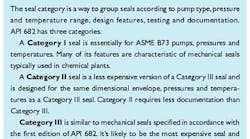The American Petroleum Institute (API) published the first edition of its seal standard, API 682, in 1994. It differed from other equipment standards in several ways, most notably because it prescribed certain default designs and materials. One criticism of the first edition of API 682 was that its seals often would not fit into the ASME B73 (also called ANSI, chemical-duty or AVS) pumps that commonly are used in chemical plants. Although this situation sometimes frustrated both users and manufacturers of mechanical seals, it was exactly as intended by the authors of the first edition. After all, the first edition was centered on API 610 pumps used in oil refineries. Moreover, the first edition of API 682 defined only heavy-duty mechanical seals. This apparent shortcoming is addressed by the various categories of API 682, Second Edition (see Seal categories).
|
View related content on PlantServices.com |
The taskforce for API 682, Second Edition, included rotating equipment engineers from chemical plants who were interested in specifications for seals used in the ASME B73 pumps on which their plants rely. The users need a seal that is more robust than the general-purpose manufacturer's standard seal typically used in chemical duty pumps. Their concerns and requirements are addressed through the features and details of Category I seals.
Seal chambers for ASME B73 pumps don't have as much radial or axial clearance as seal chambers for API 610 pumps. The result is that seals designed for ASME B73 seal chambers must be shorter and thinner in cross section than seals designed for API 610 seal chambers. This means that seals designed for ASME B73 seal chambers will fit seal chambers on API 610 pumps, but the converse is not true. But because ASME B73 pumps usually are designed for lower pressures and temperatures than API 610 pumps, those dimensional constraints are not particularly limiting to Category I mechanical seals.
Size counts
Dimensional considerations usually are a major factor in seal selection. Although Category I specifies seal chambers in accordance with ASME B73.1 and B73.2, it's important to realize that these are really enlarged seal chambers and not the narrow, so-called "standard" cross section seal chambers of older pump designs. Also, because ISO 3069 seal chamber dimensions are even smaller than ASME B73 dimensions, it's likely that Category I seals designed for ASME B73 pumps won't fit into ISO 3069 pumpsespecially as cartridge seals. To further confuse matters, it turns out that many single seals conforming to Category II, Arrangement 1 will actually fit into ASME B73 pumps. However, dual Category II seals won't fit. Category III single seals usually won't fit ASME B73 pumps because of the additional length required for the floating throttle bushing. It's no wonder that Category I was developed.
Price matters
Category I seals are expected to be less expensive than Category II seals and certainly less expensive than Category III. One reason for the reduced cost is that Category I seals require less material because they are shorter, thinner and generally lighter in weight than their larger counterparts. Especially compared to Category III, Category I seals have a number of cost-saving features. Whereas Category III seals include a flush distribution system and floating throttle bushing, Category I seals are fitted with a single-point flush injection and fixed throttle bushing. Also, both Category I and Category II seals require significantly less documentation than Category III seals.
But when compared to the so-called manufacturer's standard seal designs for chemical duty pumps, Category I seals are expected to be more expensive. Among other reasons, the added cost of Category I comes from its machined gland plate, thicker sleeve and fixed throttle bushing. Also, API 682 dictates that Category I seals must be qualification-tested.
Because the concept of categories is new to API 682, no one really knows its effect or exactly how the categories will be applied. Because of the additional cost of Category I seals, many chemical plants likely will use a combination of manufacturer's standard and Category I seals in ASME B73 pumps, with the Category I seals being used in more severe or critical services. But many chemical plants use API 610 pumps for those severe or critical services, especially when high pressures and temperatures are involved. For its API 610 pumps, chemical plants will probably continue to use Category II or even Category III seals. No matter which way the distribution of categories develops, users now have more optionsand choicesthan ever.
Gordon Buck, P.E., is Chief Engineer-Field Operations for John Crane Inc. in Baton Rouge, La. He can be reached at gsbuck@compuserve.com or 225-751-3100.
